There are plenty of reasons zucchini stands as a perennially popular choice for us gardeners. Zucchini is a versatile and nutritious addition to our dinner dishes, a prolific grower, and a relatively easy crop to grow and maintain. So if you find your zucchini plant is dying, you’ll want to know why and how to fix it.
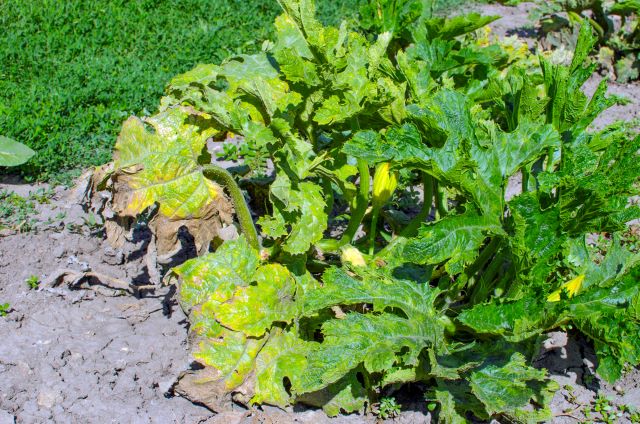
If you find your zucchini appears to be dying, some common causes include growing in the wrong climate, plant disease, garden pests, and poor soil conditions.
Let’s look at these factors in more detail. As well as some straightforward ways you can try to deal with any zucchini growing problems that pop up.
In my experience, gardeners are more likely to end up with a surplus of zucchini than a lack of it. I’ve had several friends over the years literally giving zucchinis away because they’ve run out of places to store them! It’s a nice problem to have.
Don’t worry though – if your zucchini crop isn’t quite prolific enough to force you into giving it away. If instead your zucchini is dying, appears to be wilting on the vine or not growing at all, we’re here to fix it.
Table of Contents
The Wrong Climate for Growing Zucchini
To successfully grow zucchini you will need to wait for the weather to warm up. As a warm-season crop, zucchini thrives in temperatures between 65-78°F (18-26°C).
If you try growing them before the soil and outside temps are warm enough, zucchini will struggle to grow and may succumb to plant death. A sudden cold snap accompanied by a frost could spell the end of your zucchini plant.
So wait for all chances of frost to pass before planting out your zucchini.
You can, however, get a head start on the growing season by starting your zucchini seed indoors. They can be grown near a warm sunny window or on a heat mat with grow lights.
Then as the season warms up, you can transplant your zucchini seedlings into the garden. Just be sure to harden them off first to avoid transplant shock.
Zucchini Plant Diseases Cause Plant Death
Alternaria Leaf Blight
This disease is caused by a fungus and thrives in hot and humid conditions.
You might notice it taking the form of brown or yellowish spots appearing on zucchini leaves with light green or yellow halos around them.
As these spots expand they can merge, taking up ever-increasing surface area, and eventually causing zucchini leaves to wither. In extreme cases, this can spell disaster for the zucchini plant and its fruit.
As this is a fungus-borne affliction, spores are the culprits you want to try to minimize and discourage.
Alternaria Leaf Blight Solutions
Watering your zucchini plants at their base rather than from overhead can help reduce moisture collecting on the leaves.
Similarly, ensuring your zucchini plants are kept in airy, sunny, well-spaced beds can help to ensure your zucchini aren’t being kept in moist, spore-friendly conditions.
Crop rotation is also important to try to disrupt any burgeoning spore populations and minimize the chance of blight being passed down the generations.
If you do come across what you suspect to be infected zucchini plants, trim away the affected leaves or remove the blighted plants individually if you think they’re beyond saving.
Dispose of them rather than compost them.
Mulching can also help slow the spread of any alternaria spores present in the soil if this is applied immediately after planting.
Also mulching will help suppress weeds and other unwanted competitors. Another key factor in making your zucchini bed inhospitable to leaf blight as well as other diseases.
Keeping the area clean, tidy, and weed-free throughout the growing season is important.
Finally, if you feel the need to use a fungicide, try opting for an organic copper-based variety.
Bacterial Wilt
This particular form of disease can see sections of your zucchini bed suddenly looking like they’re collapsing and dying. If the cause of your zucchini plants flopping about anaemically is not just from a lack of water, it could be bacterial wilt.
Zucchini leaves might also turn brown or yellow before they start to wither. The disease tends to extend along the vine until plants can no longer cope.
Bacterial Wilt Solutions
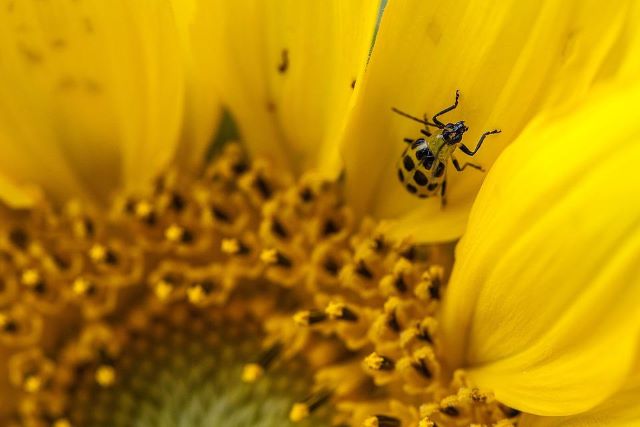
The best way to manage this is actually by managing the cucumber beetle population. It’s these little critters that carry and spread the disease.
Regular inspection of zucchini plants is key. And if you see any small, green-yellow-black beetles with spots or stripes or visible egg clusters, remove them by hand.
Floating row covers are also a good way of protecting new zucchini plants. Just remember to uncover them for pollination. Or pollinate by hand. You can read more on that in our article: Why Is My Zucchini Flowering But Not Producing?
Natural predators such as ladybugs and lacewings will also help keep your cucumber beetle population in check. So encourage them by planting predator friendly plants in the vicinity. As well as by maintaining a healthy and organic biosphere.
Finally, maintaining a clean growing area is also important for discouraging cucumber beetles to set up shop in the vicinity.
Remove any falling foliage and harvest fruit before it drops to the floor.
Rotate your crops, keep the garden weed free, and try to ensure that old organic matter doesn’t lie about in the bed. Unless it’s in the form of pre-prepared compost or dedicated mulch. This will hopefully reduce overwintering habitats for cucumber beetles.
Powdery Mildew
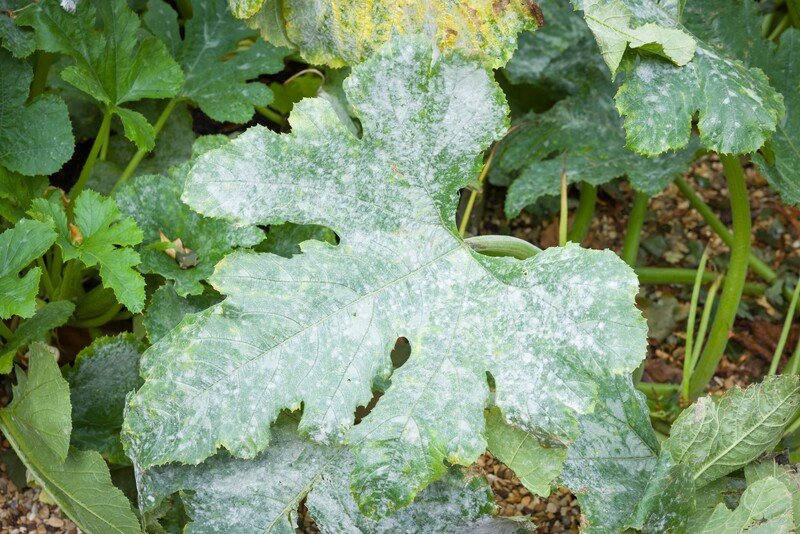
Another fungal disease, powdery mildew can make your zucchini plants look like they’ve been coated in baking flour. Although zucchini plants can survive it, severe cases can lead to a reduction in photosynthesis and stunted growth.
Powdery Mildew Solutions
As with other fungal diseases, powdery mildew can be protected against by ensuring your zucchini plants have good air-flow and are kept clear of weeds and fallen foliage.
The more space your zucchini plants have to breathe and dry out, the less chance they have of being seized upon by fungal spores looking for a moist spot to spread out.
My preferred method of dealing with powdery mildew is to use a DIY milk spray like this one. You can easily make it at home, it’s safe to use on plants and acts like a natural fungicide.
You can also consider using certain forms of organic fungicides like this one, that can be used for prevention or containment of a mildew outbreak. Although they are unlikely to eradicate an infection once it has started to spread.
Zucchini Plant Pests Cause Plant Death
Vine Borers
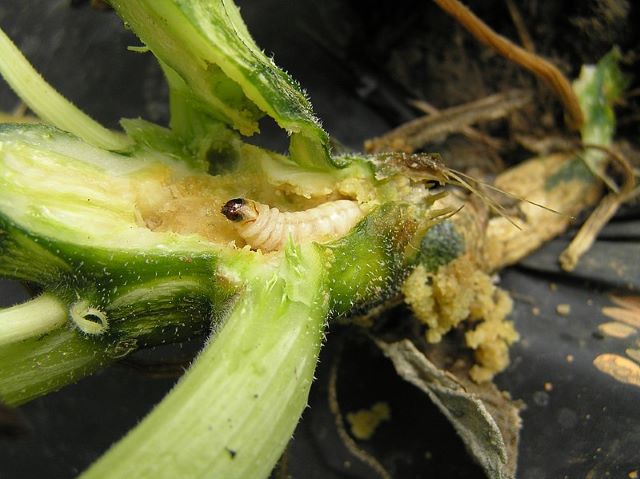
Image: Source
These voracious little tunnelers are the bane of many a squash plant and zucchini is very much on their menu. Telltale signs that vine borers been at work could be that a usually very healthy zucchini suddenly dies. With individual plants or stems collapsing in the midst of an otherwise vibrant-looking bed.
Vine borers are the larvae of a certain type of moth. A species sometimes mistaken for wasps due to their dark, striped patterning and slightly wasp-like shape.
They’ll overwinter in cocoons in the soil before emerging in the late spring to lay their eggs.
Usually, the moths will lay their eggs near the base of the zucchini plant. Either on the stem itself or on the underside of lower leaves.
When the eggs hatch, the resultant larvae start their hungry lifespans by burrowing directly into the stalk of the zucchini plant.
If you see a small, cylindrical hole surrounded by sawdust-like deposits, as if something has drilled through the base of your zucchini, then a vine borer has almost certainly been at work.
Vine Borers Solutions
At this point, it can be difficult but not impossible to remove. Although you can try getting the vine borer caterpillar out by hand using tweezers or a toothpick poked into the hole.
As with all garden pests, prevention is often more effective than eradication.
Keep an eye on your zucchini plants and check the underside of leaves for any eggs laid during the spring season. Remove gently vine borer eggs by hand if possible.
Using floating row covers can also help protect against adult moths coming to lay their eggs.
Other inventive solutions are also out there. Many gardeners swear by using aluminum foil, or a similar form of mouldable yet solid material barrier, to wrap around the base of the zucchini plant. Florist tape can also be used.
If you’re opting for this method of protection, ensure the material barrier extends beneath the soil by a quarter-inch or so. This can help discourage moths from laying their eggs in the first instance. As well as preventing caterpillars from burrowing if they do hatch nearby.
An added bonus is that this can also be effective at reducing the risk posed by other stem-nibblers. Such as cutworm.
Just be sure to replace the aluminum foil or tape every few weeks while the plant is growing. So as not to restrict growth too much at the base.
Squash Bugs
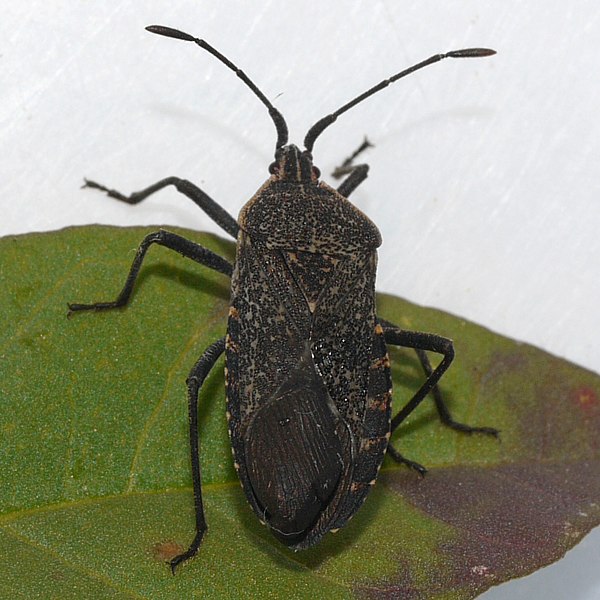
Image: Source
These small, shield-shaped insects will munch your zucchini leaves for as long as they’re permitted to.
Although most plants can survive a bit of nibbling, your zucchini’s ability to thrive and produce fruit can be seriously inhibited if squash bug diners are left unchecked to cause widespread damage to leaves.
Squash Bug Solutions
A good trick for removing squash bugs and their eggs by hand (as well as other hungry insects such as aphids) is by wrapping your hand with reversed duct tape. Then use this as a sticky surface to gently peel away any unwanted guests.
Companion planting of various forms can also act as a deterrent for squash bugs.
There is some evidence to suggest that planting nasturtiums amongst or nearby your zucchini crop can reduce squash bug populations.
Similarly, you can consider planting a trap-crop nearby in order to try to distract hungry critters.
‘Blue Hubbard’ Squash is often cited as a firm favorite for squash bugs. So try planting a bed somewhere else in the garden as a ‘sacrificial’ offering that might draw them away from your prized zucchini.
Planting plenty of flowering plants, as well as low-growing herbs nearby, will also encourage populations of beneficial insects. Garden spiders, particularly the roaming, hunting varieties enjoy preying on squash bugs and other zucchini munchers.
Remember, natural predators are nature’s way of balancing out all manner of bug populations. The more diverse your ecosystem, the less likely you are to experience an unhealthy profusion of any one species.
Related: 11 Zucchini Pests (And How to Get Rid of Them!)
Tips on Planting Zucchini and Soil Conditions
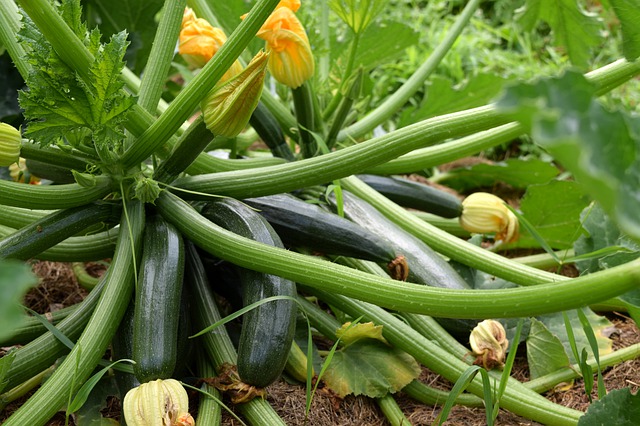
Finally, if your zucchini plants are struggling but there doesn’t seem to be any apparent symptoms of disease or signs of pests, it may be that poor soil conditions or lack of proper maintenance are holding your crop back!
Zucchini isn’t particularly demanding, but like nearly all edibles they do require well-draining soil with high organic content.
Before planting zucchini, add compost and aged manure to the soil.
In addition, a balanced organic fertilizer should do the trick to ensure that the soil has the goodness the zucchini plant needs.
Try not to overload zucchini on nitrogen, as this can cause an excess of leafy foliage growth at the expense of fruit production.
Zucchini also prefers full sun, at least 8 hours a day if possible.
Avoid the soil drying out completely. Testing the soil with your finger about 1 inch down (or use a water gauge like this one) to see whether it’s dry. This should be enough to tell you whether or not you need to top up the water.
A good mulch layer can help retain moisture as well as suppress weeds.
Too little water in the soil is not only likely to result in your zucchini going thirsty, but it can also inhibit its ability to soak up calcium.
Calcium deficiency can result in blossom end rot. Often characterized by zucchini fruits then showing dark, leathery patches that can make them look as if they’re ‘rotting’ on the vine.
You can add crushed eggshells to planting holes before introducing seedlings if a soil test indicates a lack of calcium or add crushed oyster shells like these.
Further Reading:
